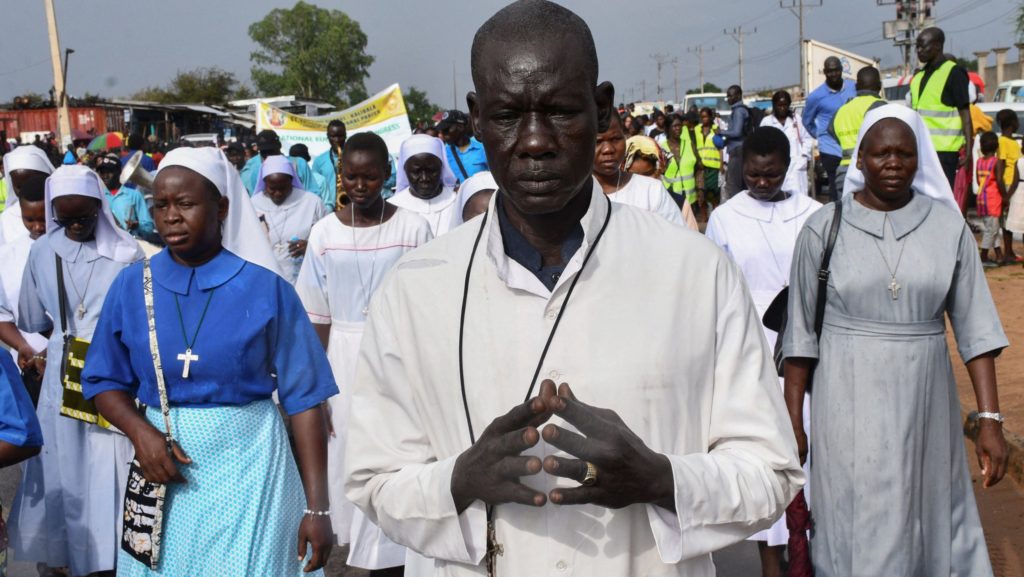Sub-Saharan Africa has replaced Europe as the locus for the world's Christians, due to both higher birthrates and Western Europe's "widespread Christian disaffiliation" -- with Christians declining as a share of the world's population due to adherents leaving the faith, according to new research by the Pew Research Center.
Christians, tallied across denominations, remain the world's largest religious group -- a majority in all regions except the Asia-Pacific, Middle East and North Africa areas -- but "they are shrinking as a share of the global population, as large numbers of Christians around the world 'switch' out of religion to become religiously unaffiliated," said Pew.
On June 9, the center released "How the Global Religious Landscape Changed from 2010 to 2020," surveying the religious makeup of 99.98% of the world's population of just under 8 billion. The data -- drawn from more than 2,700 sources, including national censuses, large-scale demographic and population surveys as well as population registers -- represents 201 countries and territories with populations of at least 100,000.
The report is the most recent in a series on global religious change, produced by Pew in collaboration with the John Templeton Foundation.
The data relies on self-identification with a religion, and does not indicate any level of belief or practice, or lack thereof.
Seven broad categories are named in the report: Christians, Muslims, Hindus, Buddhists, Jews, other religions -- which include, among others, Baha'is, Sikhs, Zoroastrians and Wiccans -- and those who are religiously unaffiliated.
While the total number of Christians in the world increased from 2.1 billion to 2.3 billion during the decade from 2010-2020, the total population of non-Christians concurrently grew by 15% to 5.6 billion.
"As a result, Christians shrank as a percentage of the global population, with their share falling from 31% to 29%," Pew said.
A number of factors influence religious demographics, such as fertility, mortality, migration and religious switching -- which Pew defines as changing in adulthood from a childhood religious group to another, or disaffiliating from religion altogether.
Ultimately, fertility and religious switching have proven decisive in shaping global religious demographics, Pew said, noting that migration cannot change the size of the global population of a given religious group, and that migrants tend to settle in nations where their religious identity is prevalent.
In sub-Saharan Africa, the overall population grew 31% to 1.1 billion from 2010-2020, with most people (62%) in the region identifying as Christians, said Pew.
The report also noted that the region's younger demographics and higher fertility rates drove religious growth among all groups except for Jews, with the entire region accounting for "most of the increase in Christian numbers, globally."
A previous Pew study estimated that Muslims had the highest fertility rates, an average of 3.1 children from 2010-2015. The same research found Christians followed, with 2.7 children.
In the new study, Pew said that while "Christians have a high fertility rate … they have been losing adherents as people switch out of Christianity to become religiously unaffiliated."
Religious switching is generally completed by the end of a person's young adult years, said Pew, citing various studies.
Religiously unaffiliated persons made for the third largest category among the global population, behind Christians and Muslims, said Pew.
As of 2020, Christians remained a majority in 120 countries and territories, down from 124 in 2010.
Among the nations where Christians represent less than half the population are the United Kingdom (49%), Australia (47%), France (46%) and Uruguay (44%) -- all of which now have 40% or more residents identifying themselves as religiously unaffiliated.
Australia saw the greatest drop in its Christian population during the report period, declining by just over 20 points from 67.1% to 46.8% and counting 2.83 million fewer Christians by 2020.
Also experiencing notable 2010-2020 downturns in their respective self-identified Christians were Chile (86% to 68.3%), Uruguay (61% to 44.5%), the United States (78.3% to 64%), Canada (67.2% to 53.3%) and the United Kingdom (62.4% to 49.4%).
While a number of nations worldwide saw drops in their Christian populations, Pew said that "many are in Europe and other Western or English-speaking places where Christian majorities have been shrinking for decades.
"This change is largely driven by high rates of Christian disaffiliation -- i.e., by people becoming religiously unaffiliated as adults after having been raised as Christians in childhood," said Pew.
Overall, Christians and Buddhists saw the greatest losses due to religious switching, with Christianity experiencing a net loss of 11.6 adults for every 100 adults raised as Christians, due to religious switching.
An outlier was the East African nation of Mozambique, which experienced a substantial increase in its Christian population, up 5% to reach 61% in 2020. Pew noted that a governmental anti-religious campaign launched by the ruling socialist Frelimo party -- which came to power following the country's independence from Portugal in 1975 -- had officially ended in the 1980s, "and the share of "Christians in that country has been increasing since."
That increase comes amid renewed persecution, with Open Doors -- which aids persecuted Christians in more than 70 countries -- finding that Mozambique's government is "still repressive," while Islamic extremists, organized crime networks and clan leaders also pose threats to the nation's Christians.
The U.S. counts more Christian residents than any other country, with more than 217 million -- or 9.6% of the world's Christians -- identifying themselves as such.
Following the U.S. are Brazil (over 168 million), Mexico (over 113 million), the Philippines and Russia (more than 102 million), and Nigeria and the Congo (each with over 92 million).
However, Dmitry Dubrovskiy, a researcher from the Institute for International Studies at Charles University in Prague, recently told OSV News that despite its majority-Orthodox populace -- and amid a government crackdown on non-Russian orthodox faith communities -- Russian society as a whole is not especially religious.
Instead, "a substantial amount of Russians definitely consider their Orthodoxy as a cultural identity,” he said, noting that just “approximately 3-7% of the Russian population regularly visit a church."
Pew noted in its new report that "while media stories in the 2010s often suggested that China was on the cusp of having the largest Christian population in the world, surveys indicate that China’s Christian population remains outside the 10 largest in the world.
"Based on religious self-identification measured in surveys, we estimate there were roughly 25 million Chinese Christians in 2020," said Pew, citing its 2023 report on "Measuring Religion in China."
In its new report, Pew noted that for some two dozen countries -- among them North Korea, which has consistently topped Open Doors' list as the most dangerous nation for Christians -- the only source for numbers is Boston University's World Religion Database.
The database itself notes that "there are a number of areas of religious life where it is impossible to obtain accurate statistics, usually because of state opposition" to faith traditions, and so "reasonable and conservative estimates are made."
A multiyear decline in Christianity in the U.S. may have leveled off, according to Pew in its 2023-2024 Religious Landscape Survey, released in February.
However, the survey found Catholics are seeing the greatest net losses of believers compared to other religions in the U.S.
The data indicated that for every one person received into the Catholic Church, another 8.4 individuals have left the faith, either altogether or for another worship tradition. This increases the trend Pew found in 2014, when 6.5 Catholics left the faith for every person who entered.
That survey also showed just 29% of the nation’s Catholics attend religious services weekly or more often. Altogether four in 10 Catholics attend religious services monthly or more.
In addition, support among U.S. Catholics for legalized abortion, homosexuality and other stances at odds with church teaching has increased over the past decade and a half.

